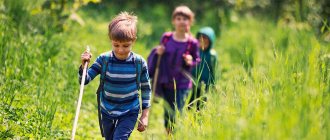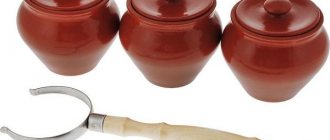Camping in the woods
Goal: to form in children an understanding of what a forest is, who lives in it and what safety rules need to be followed.
Materials: cards with images of animals and birds, cards with images of their houses.
The teacher asks the children to stand in a circle and tells them an introductory situation. The group gathered for a hike in the forest. Ask the children:
- Who lives in the forest? (animals, birds)
- What is important to take with you to the forest? (water, hat, map)
- How to behave in the forest? (watch your step, keep up with adults)
If the kids don’t know the answer to a question, the teacher tells them.
After the introductory conversation, the teacher invites the children to play a game. You need to guess who lives in which house. The teacher lays out cards with houses of animals and birds in front of the children and gives each of them several cards depicting the inhabitants of the forest. Children must find a house for everyone.
When the children have finished completing the task, the teacher explains that they should not touch these houses so as not to anger their inhabitants. After all, we don’t come to visit our friends without an invitation.
Lesson-game on life safety
Lesson-game on the topic “Man in extreme situations”
The purpose of the lesson:
In an entertaining game form, test students’ knowledge of the life safety course.
Tasks:
1. Instilling in schoolchildren the need to anticipate possible life situations at home, in nature.
2. Formation of a conscious and responsible attitude towards personal and public safety.
3. Formation of a psychological stereotype “The environment is a system that lives according to certain laws, and in order to survive, you need to know and understand these laws and use them to your advantage.”
During the classes.
1. At the beginning of the lesson, the teacher explains the goals and objectives of the lesson.
2. By drawing lots, the class is divided into two teams, captains and team names are chosen.
3. Captains select sets of task cards
1 competition
. "Warm-up"
- Why is the fire department number "01"?
Easy to remember, short number, logical to dial even in the dark
- What should you do when leaving your apartment to prevent a fire?
Turn off the lights, turn off electrical appliances
- Is it possible to break window glass at the source of a fire?
This is not possible, as the incoming air intensifies combustion.
- What should you do if the fire cuts off your way out?
Go to the back room, close the door tightly, and shout for help through the window or balcony door. Passers-by will call "01"
- Name any three reasons for the fire?
An unextinguished cigarette, playing with matches, an unplugged electric stove
- Why do people die in fires?
From smoke, fire, poisonous gases, loss of consciousness
2 competition.
"Puzzles"
- Hisses and gets angry, afraid of water. With a tongue, but does not bark, without teeth, but bites.
(Fire)
- If you feed it, it lives. If you give him something to drink, he will die.
(Fire, fire)
- Dwarves live in a wooden house; they are such good-natured people who distribute lights to everyone.
(Matches)
- My head is on fire. The body melts and burns. I want to be useful. There is no lamp, I'll shine it.
(Candle)
3 competition.
“Game situations”
(guys answer questions, show)
- Your TV lights up. Your actions? What can't you do?
I'll turn off the power and cover it with a damp blanket. Do not water with water.
- You see a man in burning clothes. What do we have to do? What can't you do?
I'll throw you on the floor and cover you with a jacket and a blanket.
Do not use a fire extinguisher
- Your clothes are on fire. Your actions? What can't you do?
I'll fall and roll on the floor
I'll cover myself with a blanket.
You can't run away.
4 competition.
“Crossword”
Guess the keyword
If you enter the correct answers horizontally, you will read the keyword in the highlighted vertical column.
Horizontal questions:
- If handled carelessly, a fire may occur.
Dangerous household appliance.
Injury that a person can receive due to careless handling of fire.
A long aid with cross bars used by rescuers to evacuate people from high-rise buildings.
Primary fire extinguishing agent.
5 competition.
"Captains Competition"
- What is evacuation?
This is an emergency exit from the danger zone during an emergency.
- What's in a fire box?
axe, shovel, fire extinguisher, gaff, and sandbox
- How should you move through a heavily smoky room?
crawling or crouching, holding onto walls.
6 competition.
“Walk over the abyss through darkness and rain”
Blindfolded and with an open umbrella, walk along a gymnastics bench, remove the blindfold and run back - a relay race. Performed by each participant.
7 competition.
“Prevent a fire”
Take out flammable objects drawn on cards (distance 5-7 m), whoever can take out the most in 1 minute. Each participant performs as many as he can within one minute.
8 competition .
“The most attentive”
Find PB violations within 2 minutes:
- The lamp is covered with fabric.
- The socket on the wall is overloaded.
The iron is on.
Electrical cable under the rug.
The curtain is too close to the stove.
The shelf hangs above the stove.
A towel hangs over the stove.
Summarizing. Winner's reward ceremony.
We end the lesson and wish you to act in life as amicably and thoughtfully as in the game. Remember: your safety is in your hands!
Be careful, insects!
Goal: to develop in children an understanding of how to behave when encountering insects.
Materials: pictures depicting various insects.
The teacher shows the children pictures of insects. For example, ladybug, wasp, rhinoceros beetle and mosquito. The teacher asks:
- Are you familiar with these insects?
- What harm can they cause?
- Is there any way to protect yourself from them?
- What to do if you are bitten?
If the kids could not answer all the questions, the teacher prompts.
Then the teacher recites the poem, simultaneously showing the movements:
I was stung by a bee (He shows with his finger how a bee stings, and the children repeat after him) I shouted: “How could you!” (Everyone shouts together, “How could you?”) The bee responds: “How could you pick my favorite flower? (Shows how he picks a flower) After all, I really needed it: (Everyone buzzes together like bees) I was saving it for dinner!” (Show how a bee eats)
Then the teacher discusses with the children why the bee stung and how it could have been avoided. It is important to convey to children the idea that insects usually do not attack if they are not disturbed.
To reinforce the topic, the teacher conducts a quick survey with the children:
- What to do if a bee or wasp is flying near you? (don't wave your arms)
- What to do if you step on an anthill? (quickly leave this place and shake off the ants)
- What to do if you see a beetle? (pass by)
Card index of games on life safety
MBDOU - kindergarten No. 7
in the middle group
Prepared by: Oshchepkova Ya.I.
Educator.
Ekaterinburg, 2022
Explanatory note
In order to make the child active in acquiring knowledge, it is proposed to accumulate, deepen and systematize it mainly through didactic games .
The advantage of using didactic games ,
in comparison with classes to enrich knowledge about life safety rules as a component of safety precautions in everyday life, it is manifested in the following: each child is as active as possible;
there is an opportunity to differentiate and systematize children’s knowledge (depending on their current level, since the games were held with a subgroup (from 2 to 8 people)
or individually; maintaining preschoolers’ sustainable interest in this activity and a high emotional background.
Selected didactic games provide the opportunity to: introduce children to sources of danger in everyday life, clarify and systematize these ideas, teach them to distinguish potentially dangerous objects; form ideas about precautionary measures and methods of safe behavior; introduce the necessary actions in case of danger.
At the same time, attention is actively developed so that the child can anticipate threats and take care of his life and health. The use of game attributes, visual aids (plot and subject pictures ,
Incentive prizes make preschoolers want to play and activate their mental processes. A positive assessment from the game character and adults allows the child to confirm his correct understanding of the norms of safe behavior.
“PICK UP A TOY FOR TANYUSHKA”
Objectives: to consolidate ideas about household objects that can/cannot be played with; develop attention; cultivate a sense of mutual assistance.
Material:
— a game card with a picture of a girl and “fun”
little men;
- pictures depicting various household items and toys.
Progress of the game: the teacher offers to help Tanya choose from the objects shown by the cheerful people those that can be played with; explain why you can't play with the others.
“ONE, TWO, THREE, WHAT COULD BE DANGEROUS - FIND IT”
Objectives: to consolidate ideas about the sources of danger in the house; develop intelligence and attention; foster a sense of camaraderie.
Rule: do not push, do not take objects from each other.
Material: layout or game corner with household items, prizes (chips or pictures )
.
Progress of the game. The teacher, or Stobed, or the child turns away and counts to 3-5 (if necessary, up to 10, and during this time the children should take from the model or in the play corner those objects that, in their opinion, may be dangerous. Then each explains his choice. Answers are rewarded with prizes.
“WHAT DO WE KNOW ABOUT THINGS?”
Objectives: expand children’s understanding of the rules of safe behavior at home; develop attention and memory; cultivate a sense of cooperation.
Material:
* four game cards depicting a cut, burn, hand injury and fire;
* pictures depicting various household items.
Progress of the game. 4 children take part in the game, each of them takes a game card with the image of an “injury”
.
The teacher (hereinafter referred to as the child)
is the leader.
He picks up a picture of an object one by one. Participants must guess what injury could result from improper handling of this item, match it to their card and take the picture .
When selecting, the child must explain why this or that object is dangerous and tell the rules for handling it. "SNAIL HOUSE"
Objectives: generalize children’s ideas about the rules of safe behavior; develop protective self-awareness; foster a sense of cooperation and strengthen numeracy skills.
Rule: follow the order.
Material: playing field with a picture of a snail, inside the house of which various household items are drawn; chips; cube.
Progress of the game. Children take turns throwing the dice and moving their piece by as many spaces as there are dots on the dice. Each player talks about the picture ,
on which its chip stands: what is depicted, the rules for handling this item.
"CONNECT THE DOTS"
Objectives: to consolidate ideas about sources of danger in everyday life; develop fine motor skills, strengthen the skills of using a pencil, the ability to draw a line along the dots; develop the ability to complete a task that has been started.
Material: sheets depicting the outlines of objects (from dots)
.
Assignment: connect the dots, color and tell why this object is dangerous.
"PUT IT IN PLACE"
Objectives: to consolidate ideas about the rules of safe behavior, to develop knowledge that for safety all objects must be put back in their places; develop observation and attention; cultivate a desire to maintain cleanliness and order at home and in kindergarten.
Material: playing field with a picture of a kitchen; pictures-objects .
Progress of the game. The box contains pictures of objects (image down)
.
Each child takes one picture and puts it on the playing field - in place, explaining his choice.
Options.
*
Pictures-objects are “scattered” .
Children take turns putting them in place.
* On the layout, put all the items in their places, first in the “kitchen”
, and then throughout
the “apartment”
.
* The same in the play corner.
“SO AND NOT SO”
Objectives: to teach to distinguish life-threatening situations from non-dangerous ones; develop attention; cultivate a desire to comply with safety rules.
Material:
* 2 cards - with a red and a green circle,
* pictures depicting dangerous and safe actions of children.
Rules: under a red card (circle)
put
pictures depicting life-threatening actions of the child, under the green - non-hazardous (allowed) ones
.
Options:
* individually with the teacher,
* several children take turns explaining their choice.
Approximate content of pictures :
the child sits, reads, watches TV, plays with matches, stands on the windowsill, vacuums, plugs in the TV, takes a toy from the top shelf of the closet, runs on a wet floor, plays on the balcony, etc. for all types of dangerous situations .
Option: “POSSIBLE - CAN’T”
(using photographs of children)
.
Unlike the pictures ,
the use of photographs makes it possible to show the child a real dangerous everyday situation, to draw the preschooler’s attention to details, to consolidate knowledge about sources of danger, methods of safe behavior and precautions.
In addition, this technique acts as a kind of “bridge”
from knowledge to the formation of skills: the child, by examining and analyzing (
“talking out”
) the depicted situation, is confirmed in the norms
(rules)
of safe behavior.
To do this, you can ask some parents to photograph their child in various home situations that are close to dangerous (for example, looking into the oven, cutting bread, standing on the windowsill, playing with toys, playing with a hammer and forks, etc.). The resulting guide, “Do’s and Don’ts”,
will be looked at and discussed with pleasure by children
(even without the participation of adults)
.
"ONE HUNDRED TROUBLES"
Objectives: to consolidate ideas about dangerous situations that can happen at home, to teach the rules of safe behavior at home; develop memory, attention; cultivate a sympathetic attitude towards the victim.
Material: pictures depicting children in a dangerous situation at home.
Game progress: several pictures lie face down on the table. The child chooses any one, examines it and tells: what is depicted on it, why this happened to the child, what he did wrong, what should the child do now.
“I’M NOT AFRAID OF NEEDLES”
Objectives: strengthen the ability to safely handle a needle; develop fine motor skills; cultivate attention and perseverance.
Material: needles and threads attached to the base of the box; buttons.
Tasks: assemble a “pyramid”
from buttons, stringing them on a needle and thread;
assemble the “beads”
by threading a needle and thread through both button holes.
"WE ARE THE RESCUE"
Objectives: to consolidate ideas about dangerous situations in everyday life, about the correct actions in specific situations; develop attention; cultivate a sympathetic attitude towards the victim.
Material:
* game map with three empty windows (one at the top, two at the bottom)
;
* pictures depicting children in specific dangerous situations;
* a set of cards depicting the actions that need to be performed in a given situation.
Progress of the game. The teacher places a picture depicting a dangerous situation on the game The child examines it and, from all the cards depicting actions, selects the two correct ones and lays them out sequentially.
"PUT IT IN PLACE"
Objectives: to consolidate ideas about the rules of safe behavior, to develop knowledge that for safety all objects must be put back in their places; develop observation and attention; cultivate a desire to maintain cleanliness and order at home and in kindergarten.
Material: playing field with a picture of a kitchen; pictures-objects .
Progress of the game. The box contains pictures of objects (image down)
.
Each child takes one picture and puts it on the playing field - in place, explaining his choice.
Options.
Pictures of objects are “scattered” on the playing field . Children take turns putting them in place. On the layout, put all the items in their places, first in the “kitchen”
, and then throughout the
“apartment”
.
Intellectual game “Child Safety in Nature” for the older children of the kindergarten group
Kalinina Nadezhda Vladimirovna, teacher at MBDOU "Kindergarten No. 2", the city of Okhansk, Perm Territory. Intellectual game “What? Where? When?" on safe behavior of children in nature. (Senior preschool age.)
Goal: consolidation of knowledge on safe behavior in nature.
Objectives: 1. To consolidate knowledge about correct behavior in nature during a thunderstorm, when meeting wild animals and insects. 2. Expand knowledge about edible and inedible mushrooms and poisonous plants. 3. Develop children's speech. 4. Consolidate knowledge about the benefits and harms of fire.
Necessary equipment and materials: images of fairy-tale characters (Baba Yaga, Karabas Barabas, Vupsen and Pupsen, the Snow Queen, Dyudyuka, Mrs. Belodonna), images of various herbs, berries, mushrooms, dangerous situations in nature, images of insects, a black box, a rotating disk with arrow, multimedia equipment, box of matches.
Children sit at a table with a disk with an arrow on it. Around the disk are envelopes with tasks from fairy-tale characters. During rotation, the arrow points to the target.
Progress: Educator: Guys, our kindergarten received a letter from fairy-tale characters. They want to test your knowledge of safe behavior in nature. They are confident that you know nothing and they will easily win this competition against you. Do you want to win against them? (Yes.) Then rotate the arrow and select the first task.
Assignments in envelopes.
1. Baba Yaga is playing against you (on the screen there is an image of Baba Yaga under a tall lonely tree during a thunderstorm). Assignment: Guys, please tell me what I did wrong and advise me on how to do the right thing. (During a thunderstorm, you should not stand under a tree, run, talk on the phone, or hold a metal object in your hand).
2. Vupsen and Pupsen are playing against you. (Give the children pictures with different berries and herbs.) Assignment: Guys, we really love to chew grass and berries, but some of them give us stomach ache, look at the pictures - this is what we recently ate, which could make our stomachs ache and what should we do if we don’t know the edible herb or berry in front of us. (Crow’s eye)
3. The Snow Queen is playing against you. Assignment: look at the picture and say what rule of safe behavior is shown here. (When encountering wild animals, you must be quiet and carefully move away from him).
4. Black box. Dyudyuka is playing against you. She hid an object in this box and wants you to guess what is there. Assignment: There is an object hidden in the box that will help you in the forest, but on the other hand, this object can cause great trouble. Hint - riddle: This is a cramped, cramped house: A hundred sisters are huddled in it. And any of the sisters can flare up like a fire! Don’t joke with your Thin sisters... What item did Dyudyuka wish for? (Matches). How can matches help in the forest? (you can light a fire to cook food and keep warm, fire scares away wild animals). What harm can a fire cause in a forest? (if you do not put out the fire, a fire may start in the forest and all the animals may be left homeless or die). 5. Karabas Barabas is playing against you (images of mushrooms are placed in a basket). Assignment: Guys, I am a very harmful person and therefore I am giving you the most insidious task. I collected all the mushrooms that came my way in the forest. I want you to choose only edible mushrooms from the basket. Let's check if you have chosen the right mushrooms, look at the screen. (The correct answer appears on the screen.) Who can name these mushrooms? (Boletus, boletus, boletus, boletus, russula, boletus). Why are boletus and boletus called so? (Because they grow under birch and aspen).
6. Mrs. Belodonna is playing against you. Assignment: look at the pictures, what insects do you know? Which of them can be dangerous to humans? What rules for safe communication with these insects do you know? (Do not wave your hands in front of a wasp or bee, do not disturb or destroy their nests, use insect repellents). And now to sum up. You guys completed all the tasks and become winners in our competition. Which task was the most difficult for you to complete? Which task did you like the most?




